 Email: support@vespaagogo.com
Email: support@vespaagogo.comFood & Beverages
- Home
- Travel Tips
Hu Tieu Noodles: The Ultimate Guide to Saigon's Secret Soul Food
2025-10-30
When people talk about Vietnamese cuisine, Phở is often the first word that comes to mind, almost as a reflex. It's a magnificent culinary ambassador, a symphony of aroma and flavor that has rightfully conquered the world. But to think of Vietnamese noodles as only Phở is to read just the first chapter of an epic story. In Saigon, there is another, arguably more diverse and deeply personal noodle soup that truly captures the city's soul. That noodle soup is Hủ Tiếu.
This is not just another dish; it's an entire culinary universe. It’s a choose-your-own-adventure in a bowl, an indispensable part of the DNA of daily life and collective memory for the people of this city. It’s the breakfast that starts the day, the quick lunch, and the comforting dinner after a long, weary day. From elegant, multi-generational family restaurants to humble, phantom-like carts that appear in alleys after dark, Hủ Tiếu noodles are everywhere, in countless forms and flavors.
But what exactly is it? How does it differ from Phở, and why does it hold such a special, sacred place in the heart of this city? Let's embark on a journey to decode all these questions and fully understand the dish known as the "culinary soul" of Saigon.
Hủ Tiếu vs. Phở: What's Actually the Difference?
This is the most fundamental and important question for anyone new to the world of Hủ Tiếu noodles. To place these two iconic dishes side-by-side isn't about determining which is superior, but about appreciating two completely different culinary philosophies that reflect the culture and terroir of Northern and Southern Vietnam.
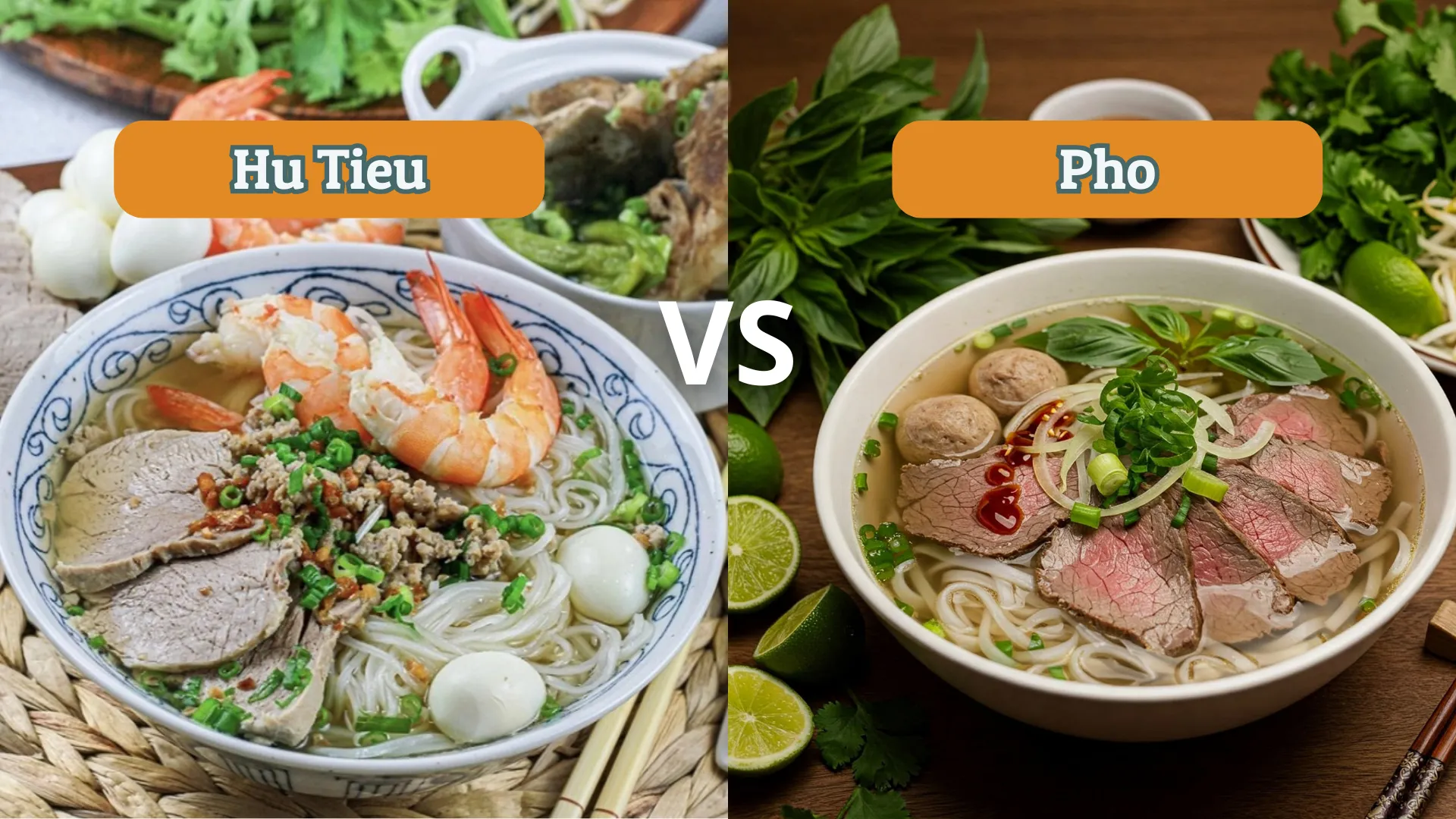
Core Difference #1: The Philosophy of the Broth
- Phở - A Symphony of Spices: The broth in Phở is a masterpiece of aromatic complexity. It's simmered for hours with beef or chicken bones, infused with charred onion and ginger. But what defines its soul is the warm, fragrant bouquet of spices: star anise, cinnamon, cloves, and cardamom. This aroma is bold, distinctive, and capable of evoking powerful memories. Phở broth is like a warm embrace, designed to conquer your senses from the very first spoonful. It is the main character, the stage upon which all other ingredients perform.
- Hủ Tiếu - The Purity of a Clear Soup: In contrast, the broth for Hủ Tiếu noodles pursues a different philosophy: clarity and subtlety. Its foundation is typically pork bones, simmered gently to extract a natural, clean sweetness. This sweetness is deepened by humble yet powerful ingredients: daikon radish for a clean, refreshing taste, and dried squid or shrimp for a gentle, oceanic umami. The broth is intentionally light and does not use strong, overpowering spices. It acts as a perfect, clean canvas designed to highlight the diverse flavors of its toppings. It's less of an "embrace" and more of a polite "handshake," inviting you to discover the treasures within the bowl.
Core Difference #2: A Universe of Noodles
- Phở - A Commitment to One: Phở has one true noodle: the soft, flat rice noodle known as bánh phở. Its texture is perfect for soaking up the aromatic broth. This consistency is its strength.
- Hủ Tiếu - A Creative Playground: Hủ Tiếu noodles are a festival of textures. This variety is essential to its identity. You can find:
- Standard Rice Noodles: Soft and thin, similar to Phở noodles but often narrower.
- Chewy Tapioca Noodles (Hủ Tiếu Dai): A true star. These noodles are made with tapioca starch, giving them a wonderfully chewy, springy, and slightly translucent quality that provides a delightful bite.
- Glass Noodles (Miến): Clear, thin noodles made from mung bean starch, which are soft and slippery.
- Large Rice Sheets (Hủ Tiếu Hồ): Wide, soft sheets of rice flour, a specialty in the Teochew-style version of the dish.
Core Difference #3: A Galaxy of Toppings
- Phở - The Master of Specialization: Phở toppings are focused and specialized, primarily revolving around beef (rare steak, brisket, flank, tendon) or chicken. This combination has been perfected over decades into a culinary classic.
- Hủ Tiếu - The "Surf and Turf" Spirit: Hủ Tiếu noodles open a door to endless abundance. A standard bowl is a harmonious blend of land and sea: slices of lean pork, savory ground pork, bright red shrimp, and creamy quail eggs are all common. More elaborate versions include chewy pork heart, earthy liver, tender pork ribs, and even seafood. This combination creates a multi-layered experience of flavor and texture in a single bowl.
Expanding the Noodle Map: To further situate Hủ Tiếu noodles on Vietnam's culinary map, its clean, savory flavor is also worlds apart from other famous noodle soups. It lacks the spicy, lemongrass-infused, and pungent shrimp paste kick of Bún Bò Huế, the signature noodle soup of Central Vietnam. It also doesn't have the tangy, tomato-and-crab-based sweetness found in Bún Riêu, a favorite from the North. Hủ Tiếu proudly stands on its own with the signature sweet, subtle, and versatile character of the South.
What Does the Name "Hủ Tiếu" Actually Mean?
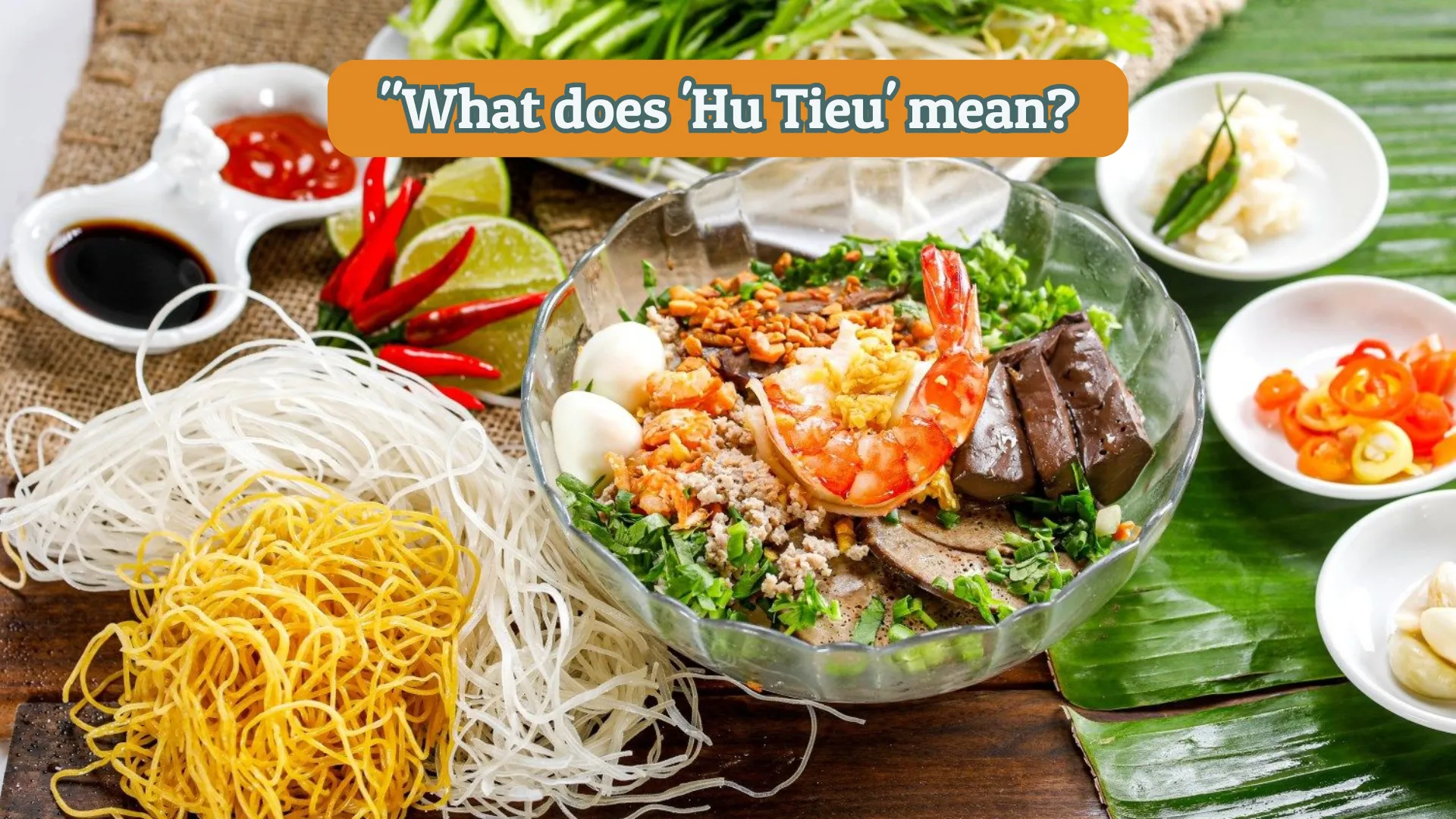
To truly understand a dish, it helps to understand its name. "Hủ tiếu" is not a native Vietnamese word. It's a loanword, a living testament to the rich history of cultural exchange in the Saigon-Gia Dinh region.
The name comes from the Teochew-speaking Chinese community who migrated to Vietnam centuries ago. It's a direct phonetic transcription of the Teochew word "粿條" (pronounced Guǒ tiáo in Mandarin). Let's break down the two characters for the official hủ tiếu meaning:
- "粿" (Guǒ / Hủ): This character refers to all kinds of cakes, dumplings, or food products made from rice flour. It signifies the core ingredient.
- "條" (Tiáo / Tiếu): This character simply means "strip," "thread," or "noodle."
When combined, the hủ tiếu meaning is simply "rice noodle threads." This humble name describes the dish by its most fundamental component: the noodle itself. It doesn't describe the broth or the toppings, which helps explain why it has evolved into so many different variations. As long as it's built on a foundation of rice noodles, the creative possibilities are endless.
Which Famous Types of Hủ Tiếu Noodles Must I Try?
The world of Hủ Tiếu is vast, but to begin your journey, there is a "Holy Trinity" that every newcomer must experience to grasp the essence of the dish. Each style tells a different story and offers a unique flavor profile.
1. Hủ Tiếu Nam Vang: The Rich and Royal King

Often called the "king of all hủ tiếu," Hủ Tiếu Nam Vang is the most luxurious, complex, and popular version found in restaurants. "Nam Vang" is the Vietnamese name for Phnom Penh, the capital of Cambodia. This dish is a precious culinary heritage brought to Saigon by Chinese Cambodians.
- What makes it special? The magic of Hủ Tiếu Nam Vang lies in the perfect balance between its rich broth and its spectacular array of toppings. The pork-based broth is elevated with the deep umami of dried shrimp and savory ground pork sautéed with garlic. A full bowl is a visual and culinary feast, featuring fresh shrimp, sliced pork, ground pork, quail eggs, chewy pork heart, and earthy pork liver, all garnished with garlic chives and celery.
- A must-try experience: Don't just have it as a soup. Order the "khô" (dry) version for a completely different and amazing experience (more on this below).
2. Hủ Tiếu Mỹ Tho: The Soulful Melody of the Mekong Delta
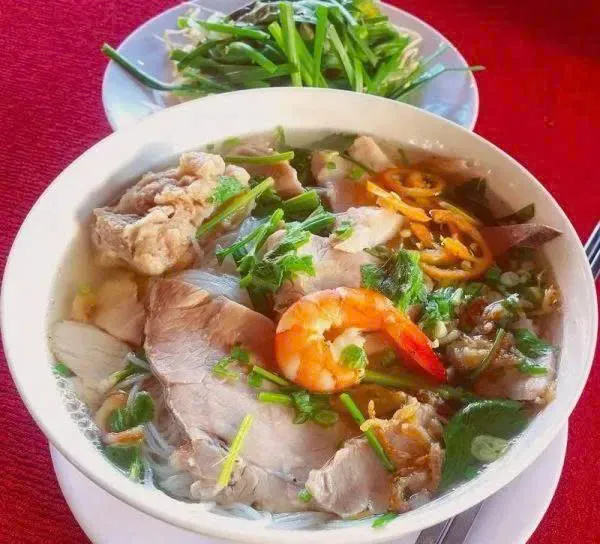
If Hủ Tiếu Nam Vang is the sophisticated city aristocrat, Hủ Tiếu Mỹ Tho is its charming, rustic cousin from the countryside. Hailing from Mỹ Tho, the gateway city to the lush Mekong Delta, this version fully embodies the flavors of its origin.
- The noodle is the star: The defining feature of Hủ Tiếu Mỹ Tho is its unique noodle. The rice noodles here are thicker, clearer, and possess a signature chewy and "crisp" texture. Even after being blanched in boiling water, they remain firm and springy, never mushy. The sensation of chewing these noodles is truly unique and addictive.
- The overall flavor: The broth of Hủ Tiếu Mỹ Tho is often lighter and cleaner than that of Nam Vang, allowing the unique noodle texture to shine. Toppings are classic but refined, featuring pork and fresh seafood, sometimes with a regional twist like crispy fried pork skin.
3. Hủ Tiếu Gõ: The Immortal Soul of Saigon's Alleys

This is not just a dish; it's a cultural phenomenon. Hủ Tiếu Gõ is the symphony of the Saigon night, a collective memory for generations.
- The signature sound: The name "Hủ Tiếu Gõ" literally means "knocking noodles." It comes from the vendors' unique way of advertising. Instead of shouting, they push their mobile carts through the alleys and tap two wooden sticks or metal spoons together, creating a rhythmic clack-clack-clack sound that echoes in the night. That sound was a beloved signal that a hot meal was near.
- The beauty of simplicity: A bowl of Hủ Tiếu Gõ is the complete opposite of the lavish Nam Vang. It is minimalist perfection: a light, clear broth, a small serving of thin noodles, a few paper-thin slices of pork, some bouncy pork meatballs, and a sprinkle of crispy pork lardons and chives. Its simplicity, incredibly low price, and comforting warmth make it the ultimate late-night food for students, workers, and night owls.
Insider tip: Locals say the best Hủ Tiếu Gõ carts don’t appear until after 8 PM, when the city quiets down and the night food scene truly begins.
Look for small crowds gathered near alley 177 Cách Mạng Tháng 8 or on Nguyễn Thượng Hiền Street - these late-night stalls are loved by Saigonese for their clear broth and smoky pork aroma.
What's the Story Behind "Hủ Tiếu Gõ" (Knocking Noodles)?
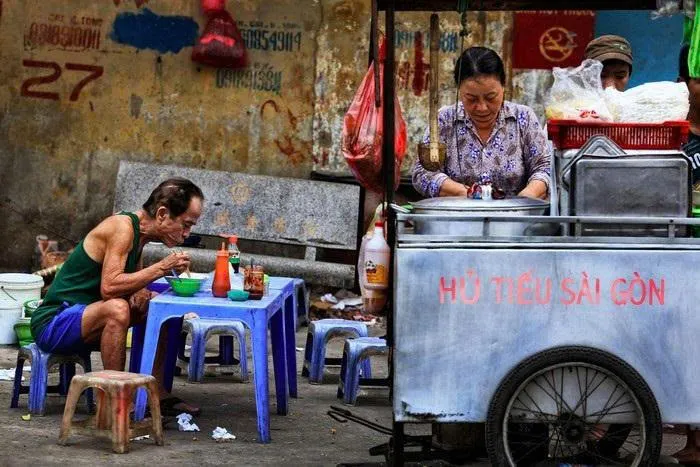
As mentioned, the name comes from the "knocking" sound. But what makes Hủ Tiếu Gõ so special is the entire culture built around it.
- Mobility and Accessibility: Hủ Tiếu Gõ is served from compact mobile carts that can navigate the narrowest alleys, bringing food directly to people's doorsteps. It was Saigon's original food delivery service.
- An Icon of Affordability: In a rapidly developing and increasingly expensive city, Hủ Tiếu Gõ remains incredibly cheap. It's a "culinary safety net," ensuring that anyone, no matter their budget, can afford a proper, hot meal.
- A Unique Dining Experience: You don't eat Hủ Tiếu Gõ in a restaurant. You eat it on a tiny plastic stool on the sidewalk, under the dim yellow glow of a streetlamp. This setting erases all social distance, as people from all walks of life gather around the cart, slurping their noodles together. It's a uniquely Saigonese experience where simplicity and community are celebrated.
Is Hủ Tiếu Always a Soup? The "Dry" Version Explained
Absolutely not! It would be a huge mistake to explore the world of Hủ Tiếu noodles without trying the "Hủ Tiếu Khô" (Dry Hủ Tiếu) version. This is an incredibly popular way to enjoy the dish and offers a completely different flavor profile.
When you order "khô," you will be served a perfect duo instead of a single bowl:
- The Main Bowl (Noodle Bowl): The noodles are blanched until perfectly cooked, then drained and tossed in a "secret" house sauce. This dark, savory sauce is usually a masterful blend of soy sauce, oyster sauce, sugar, and fragrant fried garlic oil. All the toppings - pork, shrimp, quail eggs - are arranged neatly on top of the sauced noodles.
- The Side Soup: The pure, concentrated essence of the broth is served in a small, separate bowl on the side, usually with some chives and ground pork.
How to eat it: You take a bite of the intensely flavorful sauced noodles, enjoying the chewy texture and the rich taste of the toppings, then follow it with a spoonful of the hot, clean broth to balance your palate. The contrast between the rich noodles and the light soup creates an incredibly satisfying and addictive experience.
Where Can I Find the Best Hủ Tiếu in Saigon?
Saigon is the capital of Hủ Tiếu, a city where you can find a good bowl on nearly every street corner. However, for the ultimate experience, here are some legendary spots that have stood the test of time, making them the destinations for the best hủ tiếu in Saigon.
1. The Authentic Hủ Tiếu Nam Vang Experience
Nhan Restaurant - Phnom Penh Style Rice Noodle Soup (Nhân Quán - Hủ Tiếu Nam Vang)
A reliable spot serving customers 24/7, Nhan Restaurant is the ideal destination for anyone craving a hearty bowl of Hủ Tiếu Nam Vang at any time of day. While the space is often crowded with tables placed close together, the main focus is on the food quality and the swift service from its young, energetic staff.
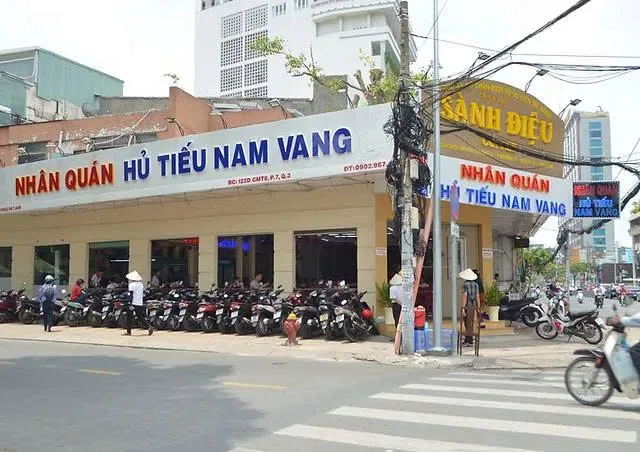
The broth is a highlight here, beloved for its delicate, clear sweetness, making the soup version a top choice for many. Meanwhile, the dry version is just as appealing, featuring chewy noodles and a rich, well-balanced mixing sauce. A signature feature of the restaurant is its incredibly generous toppings - so plentiful that you might finish your noodles and still have toppings left over. With its hearty, high-quality bowls available around the clock, Nhan Restaurant offers a delicious and convenient dining experience.
- Address: 122D Cach Mang Thang Tam Street, Vo Thi Sau Ward, District 3, HCMC
- Price: 93,000 VND (~$3.65 USD) for all noodle dishes
- Opening Hours: 24/7
Hủ Tiếu Hồng Phát
Hồng Phát offers a slightly different, yet equally beloved, interpretation of Hủ Tiếu Nam Vang. It’s famous for a broth that is noticeably lighter and clearer, with a clean, delicate sweetness that many find incredibly comforting. The toppings are always fresh and perfectly cooked, providing a well-balanced bowl that is rich without being overwhelming.
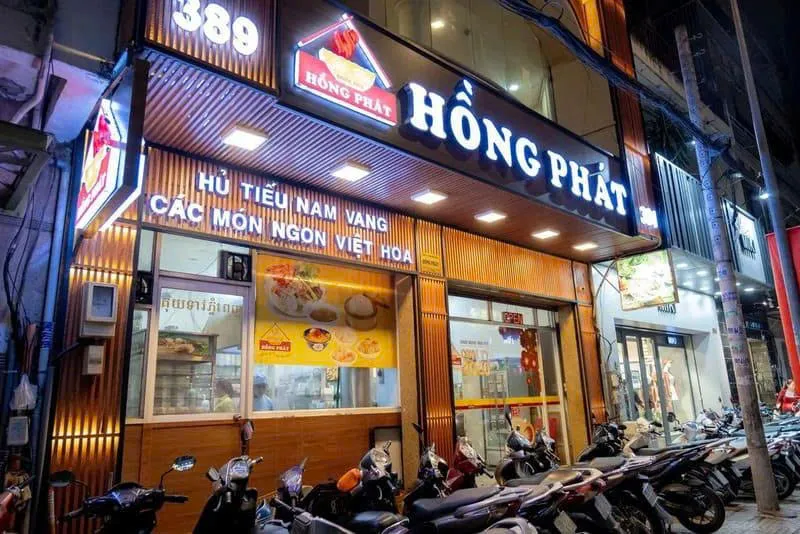
Compared to more traditional spots, the restaurant provides a more comfortable and family-friendly dining experience. The space is clean, spacious, and air-conditioned, making it an excellent choice for a relaxed meal. The staff is known for being friendly and attentive. If you prefer a more subtle symphony of flavors in a pleasant setting, Hồng Phát is an outstanding choice.
- Address: 389 Vo Van Tan Street, Ward 5, District 3, HCMC
- Price: 65,000 - 95,000 VND (~$2.6 - $3.8 USD)
- Opening hours: 6:00 AM - 10:30 PM
2. To Taste Authentic Mekong Delta Styles
Hủ Tiếu Mỹ Tho Thanh Xuân

Thanh Xuân is a living legend, a true time capsule hidden in a narrow alley for over 70 years. Coming here is not just about eating; it's about tasting a piece of Saigon's history. The restaurant is celebrated for its unwavering commitment to the original flavor of Hủ Tiếu Mỹ Tho, with the noodle itself being the absolute star - uniquely chewy, firm, and never mushy. The broth is clean and subtle, designed to perfectly complement the signature texture of the noodles.
The dining experience is as authentic as it gets - a very basic, old-school setup where the food is the sole focus. Don't expect fancy decor, but do expect a bowl of hủ tiếu that has remained unchanged for generations, served with history and soul. It's an essential pilgrimage for any serious food lover.
- Address: 62 Ton That Thiep Street, Ben Nghe Ward, District 1, HCMC
- Price: 50,000 - 70,000 VND (~$2.0 - $2.8 USD)
- Opening hours: 6:00 AM - 13:30 PM (Often sells out early)
Hủ Tíu Cần Thơ (at Nguyễn Trường Tộ Street)
This spot stands out with its authentic Cần Thơ-style flavor, another gem from the Mekong Delta. The signature noodles are uniquely chewy yet remarkably slippery and translucent, paired with a rich and savory broth praised for its deep, sweet flavor from simmered bones. The menu is diverse, but the special bowl (tô đặc biệt) is a must-try, loaded with full toppings including a succulent pork knuckle (giò heo).
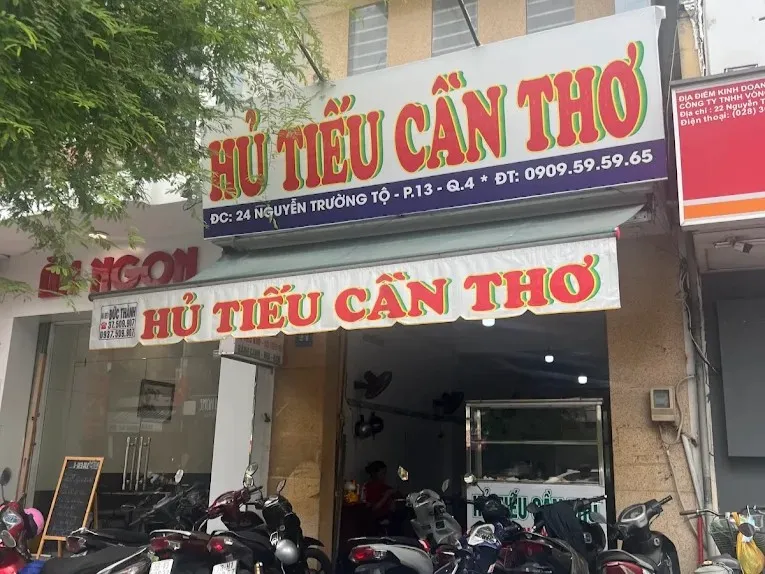
The restaurant is exceptionally clean and well-organized, creating a comfortable dining atmosphere that feels both local and welcoming. It's often bustling, especially at lunchtime, but the service is fast and the owner is known for being cheerful. This is an excellent spot to enjoy a high-quality bowl of Mekong Delta noodles in a pleasant setting.
- Address: 24 Nguyen Truong To Street, Ward 12, District 4, HCMC
- Price: 40,000 - 70,000 VND (~$1.6 - $2.8 USD)
- Opening hours: 10:00 AM - 9:00 PM
Hủ Tiếu Cả Cần
Cả Cần is a beloved institution in the heart of Cholon (Chinatown), famous for serving two local legends under one roof: Hủ Tiếu Mỹ Tho and bánh bao (steamed buns). The hủ tiếu here is a solid, classic rendition of the Mỹ Tho style, with a well-balanced broth and fresh toppings. Ordering a bowl of noodles along with one of their famously fluffy and savory steamed buns is a classic local food combo.

The atmosphere is exactly what you'd expect from a famous Chinatown eatery: constantly busy, a bit noisy, and buzzing with energy. Service is fast and functional, designed to serve the perpetual stream of hungry customers. It's the perfect place to refuel while soaking in the vibrant, authentic atmosphere of District 5.
- Address: 110 Hung Vuong Street, Ward 9, District 5, HCMC
- Price: 50,000 - 75,000 VND (~$2.0 - $3.0 USD)
- Opening hours: 6:00 AM - 11:00 PM
3. For the Hủ Tiếu Gõ Street Food Experience
There are no fixed addresses! And that is the beauty of it. The hunt for Hủ Tiếu Gõ is part of the experience. The best advice is to hop on a scooter or take a walk through dense residential areas in the evening (after 7 PM). Districts like District 3, District 4, Phu Nhuan, and Binh Thanh are prime hunting grounds.
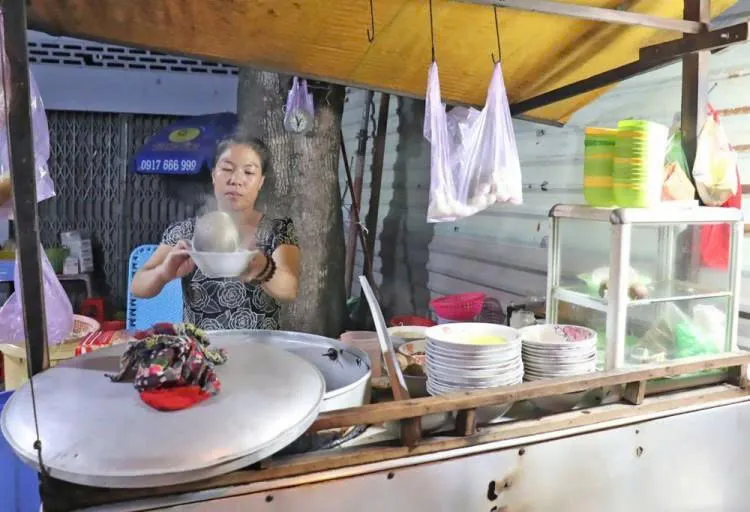
How to find it? Use your ears more than your eyes. Listen for that distinctive clack-clack-clack sound. When you hear it, follow it. Alternatively, look for a simple, brightly lit cart with a small crowd of locals hunched over bowls on tiny plastic stools. That's your destination. Finding it and finally enjoying that hot bowl of noodles in a quiet alley is the ultimate reward.
Sound of hủ tiếu gõ
Conclusion: More Than a Meal, It's a Journey
From the royal, elaborate bowls of Hủ Tiếu Nam Vang in long-standing restaurants to the rustic Hủ Tiếu Mỹ Tho with its taste of the Mekong Delta, and finally to the humble, steaming bowl of Hủ Tiếu Gõ on a quiet sidewalk, our journey has traversed the most diverse landscapes of this single dish. We have seen that Hủ Tiếu noodles are not just one thing, but a multi-chapter story of history, culture, and the creative fusion that defines the land of Saigon.
It represents the two extremes of a culinary culture: at once sophisticated and complex, yet also incredibly close, simple, and comforting. More than just a meal to fill an empty stomach, Hủ Tiếu is a piece of collective memory, the heartbeat of the city after dark, and a flavor that those who live far from home always yearn for. It is a testament to a Saigon that is always open, welcoming the finest influences from everywhere, only to absorb them and create a unique identity that cannot be replicated.
So, the next time you find yourself in Saigon, take a temporary leave from the familiar choices. Let your feet guide you on a true culinary adventure. Find a legacy restaurant to savor the richness of Hủ Tiếu Nam Vang, listen for the familiar "clack-clack" in a small alley, and sit down on a tiny plastic stool to slurp a bowl of Hủ Tiếu Gõ like a true local.
When you do, you will realize that you are not just searching for a delicious meal. You are searching for the very soul of this city. Because the best bowl of Hủ Tiếu is seasoned not only with spices, but with your own experiences and memories made in this incredible place.
Sang Nguyen - General Manager
I've always been fascinated by the stories behind things. For me, every street corner in Saigon, the historic heart of Ho Chi Minh City, has a tale to tell. For the last 10 years, my passion has been sharing these stories. I want to help you see beyond the surface, to feel the history, and truly connect with the culture that makes this city so special.
Other tips
- The Vietnamese Duck Egg Craze: Why This Delicacy Reigns Supreme in Vietnam
- Popular Vietnamese Snacks: 21 Street Eats You Can't Miss
- What is Vietnamese Broken Rice? History & Best Spots in Saigon
- Vietnamese Bun Rieu: The Ultimate Insider’s Guide to Vietnam’s Famous Crab Noodle Soup
- Hu Tieu Noodles: The Ultimate Guide to Saigon's Secret Soul Food
- 15+ Best Pho in Ho Chi Minh City (2025 Update)
- Common Questions for Vietnamese Food: Safety, Dietary Needs, and Tips for Travelers
- A Saigon Insider's Guide to the 20 Best Coffee Shops You Can't Miss in 2025
- Vietnamese Coffee Culture: From Foreign Plant to National Icon
- Bun Bo Hue: The Spicy Upgrade Your Pho's Been Waiting For
- What to eat in Saigon for travelers and tourists


